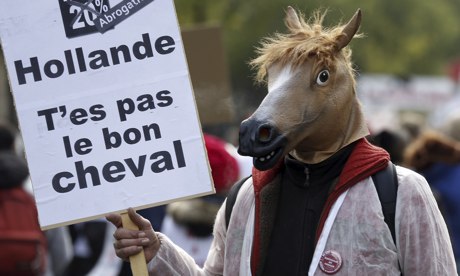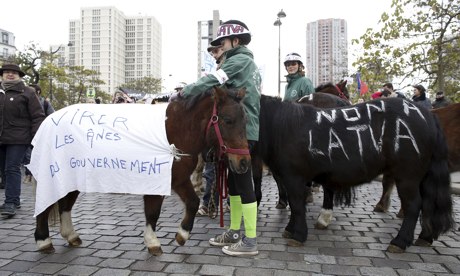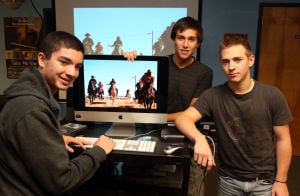Horses help us SO MUCH!!! ~Declan
Wounded vet gets help from horse therapy program
By LINDSAY S. BUCHANAN, (Florence) Morning News
Updated 5:00 am, Monday, November 25, 2013 As posted on SFGATE
TIMMONSVILLE, S.C. (AP) — For wounded Army National Guard veteran Sgt. Matthew Smith, the timing could not have been more perfect when he was connected this March to Bethlehem Therapeutic Riding Stables, and the feeling is mutual.
Gwendolyn Maddrix, founder and director of the horse therapy program run out of Tally Ho Equestrian Center in Timmonsville, said when she met Smith, she had no idea working with her first wounded veteran would turn into a huge part of her life.
A small weekend program, Bethlehem started as a tribute to her daughter, who suffers from several medical issues and who benefited from receiving therapy working with and riding horses. Now the nonprofit is looking forward to a contract with the Jacksonville, Fla.-based Wounded Warriors Project, which will result in a full-time program covering a service area with at least 6,000 wounded veterans eligible to participate.
"It's just been an amazing road," Maddrix said. "Wounded Warrior had been looking for a center for three years in this area. It's such a rewarding experience working with the Wounded Warriors, and we're excited - overwhelmed and excited at the same time - and just honored that we're going to get to be the ones who are going to work with the warriors in our area. That our little program is going to get to do something that big is just kind of mind blowing."
All of this came about when Smith, an Iraq war veteran suffering from post-traumatic stress disorder, had a motorcycle accident that left him with a traumatic brain injury and a fractured neck, leaving him in a four-month coma and a general prognosis from doctors that he would never walk or talk again, possibly living out his life in a nursing home.
Smith, then 24 years old, had returned from Iraq in 2005, not knowing how his time there had affected him. Although his mother, Shelene Smith, was concerned that something was off with her son in the months following his return, he continued to work long hours at his job while sleeping few if any hours at night.
He was riding his motorcycle one day when he had what is called a PTSD zone.
"It's a zone where you black out but don't really black out," Shelene said. "You're not familiar with anything around you, and you physically freeze. And that's what happened. He froze, and the bike just went out from under him."
Things did not look good for Smith, but after almost two years of being moved from one hospital and care center to another and battling the Veterans Administration to get Smith's injuries classified as service-connected because of the PTSD he was suffering, things finally started turning around.
When Smith finally left Walton Rehabilitation Center to move back home, he was not only talking but also walking with assistance. He had proved his critics wrong, yet he still had a long battle ahead and was left relying primarily on a wheelchair to get around and his mother to interpret his blurred speech.
It wasn't until the family connected with the Wounded Warrior Project that Shelene, Smith's strongest advocate and tireless champion, began to get some relief from the all-consuming task of making sure her son had everything he needed to gain as much independence as he could.
The Wounded Warrior program is a nonprofit that works to provide everything for wounded veterans that the Veterans Administration cannot or will not provide, including horse therapy, something that had been suggested to Shelene for her son.
After getting Smith into Wounded Warrior's Independence Program - a service that teaches everything from basic daily skills to emotional support - and securing both a life coach and a peer mentor through the program, Shelene was ready to get Matthew involved in the community.
That's when she found out about Bethlehem's horse therapy program.
"I never dreamed - I mean, Matthew never rode a horse in his life, much less with a brain injury," Shelene said laughing. "The thing I've realized about the horse program is that it teaches them discipline, organization. They have to use memory. It teaches them to respect. It teaches them balance."
Maddrix agreed and said that horse therapy is a perfect fit for Smith's challenges. When he first came to the center in March, he had to be held on the horse the entire time. Now he can ride, and occasionally even steer, by himself.
"Matt has problems with his entire left side, and he's had to learn to use that left side to stay balanced on the horse," she said. "Your body doesn't differentiate between a horse walking and you walking, so when you have a physical injury, it's just an amazing way to relearn."
At Bethlehem, an entire team works together to create a lesson plan for Matthew, including Maddrix, occupational therapist Leslie Rutter and several volunteers and instructors.
"It's a great exercise," Rutter said. "As a therapist the greatest thing about it is people are having a good time and don't even realize they're benefiting so many different areas."
Those benefits are also great for Bethlehem's other students, primarily children with autism and physical disorders but also people dealing with emotional issues.
"Horses teach you a lot, so a lot of times the horses teach the students, and there's a bond between the animal and the student," Maddrix said. "They get connected, and there's a relationship there as well as with the instructor. We focus on physical, mental and emotional, so it just depends on what the person's needs are."
Bethlehem has been a PATH International member for three years. PATH is the organization that certifies stables as being therapeutic horseback providers and grants the Premiere status necessary to contract with the Wounded Warriors Project to serve wounded veterans.
Currently Bethlehem is going through certification testing to reach Premiere status - Smith is receiving services at the stables through a subcontractor until they obtain the new rating - which will allow them to contract directly with the Wounded Warriors program.
Once the contract is secure, Bethlehem will be an official provider of horse therapy services for Wounded Warrior and the only certified center in the Pee Dee or Grand Strand areas.
That's a daunting task for Maddrix and her team, but it's one they are willing to take on if it means giving back to the ones who protect their country.
"We were really excited about working with the Wounded Warriors, but we had no idea how big it was going to be," she said. "I just feel like when God blesses you, you should not only be thankful but you should give it back."
Because of the large number of wounded veterans expected to start the program in the next year, the center is looking for volunteers and instructors. They're especially asking any military veterans or those familiar with the military to step up and help with the Wounded Warrior project.












